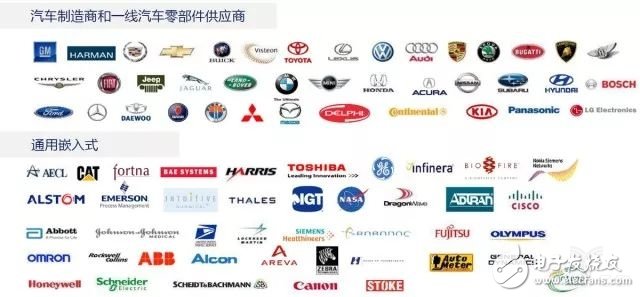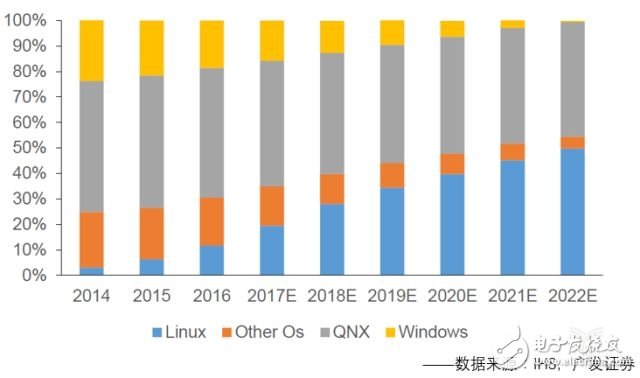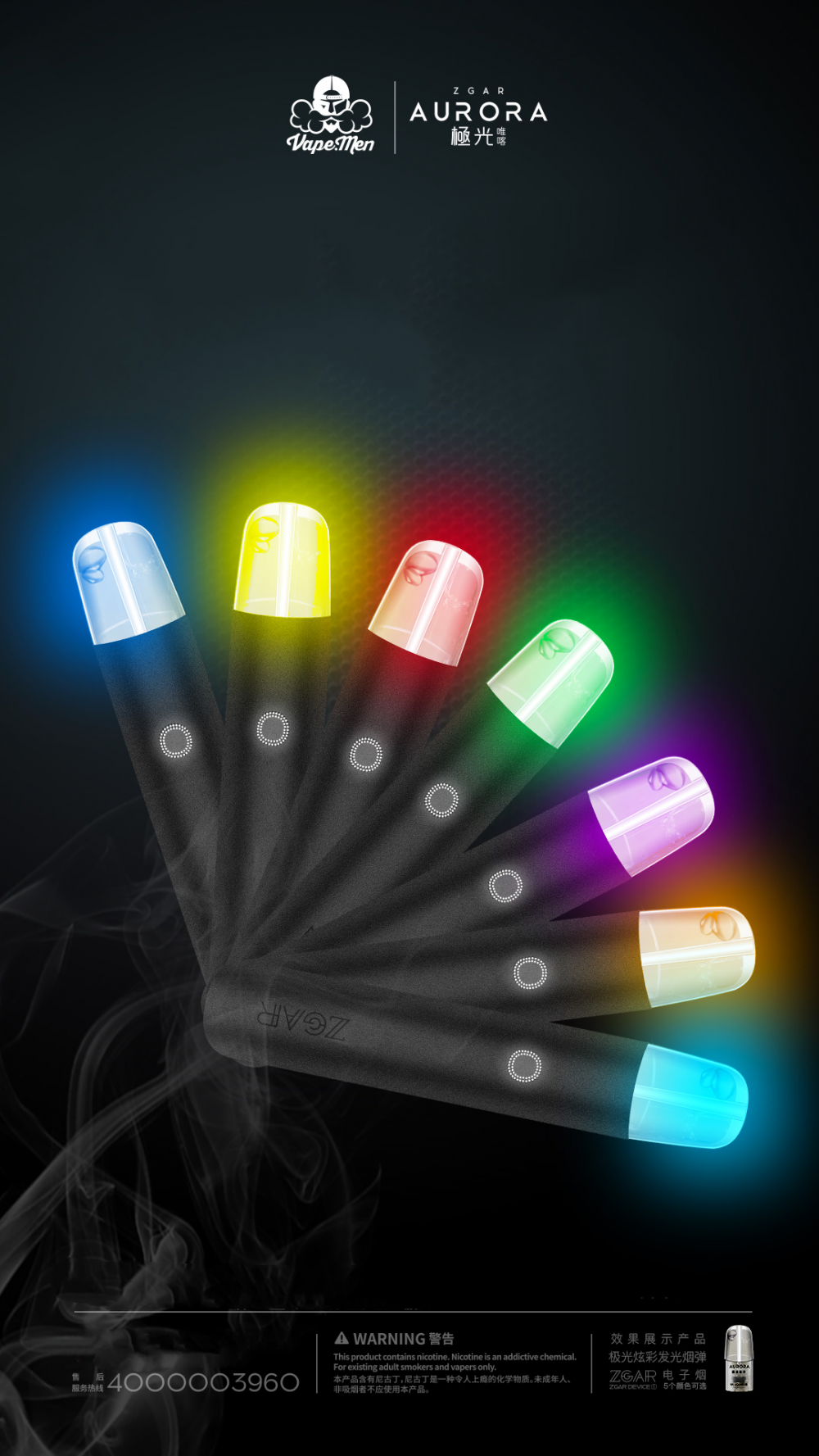Intelligentization is the main theme of current social and economic development. From PC (personal computer), smart phone to smart car, the intelligence of each field will change people's lives and bring a new industry with broad prospects. In the intelligent process, the most critical link is OS (OperaTIng System, operating system). The OS is responsible for the communication between the intelligent application and the hardware in the smart device. After the smart device develops to a certain extent, the OS is generally required to be equipped; and each successful OS product can be reminiscent of a great company. For example, Windows has made Microsoft a dominant player in the PC era; while Android and iOS have made Google and Apple shine in the era of smartphones. The car is considered to be the next smart product with great market prospects. What kind of market structure is the car operating system, and what kind of strategic opportunities will the car intelligentization bring? This article will be a preliminary review and discussion of common vehicle operating systems, and welcome entrepreneurs or investment peers in related fields to interact.

To talk about smart car operating systems, you must first understand car electronics. Traditionally, automotive electronics can be easily divided into two categories: one is an automotive electronic control device that sends commands to actuators (such as electronic valves, relay switches, actuator motors, etc.) to control key vehicle components (such as engines). Coordination of gearboxes, power batteries, etc., common engine control, chassis control, body electronic control.
The other type is in-vehicle automotive electronic devices, which are electronic devices that can be used independently in the automotive environment. They are not directly related to the performance of the car itself. Common examples include driving computers, navigation systems, car audio and TV entertainment systems, and vehicle communication systems. , Internet devices, etc. Since most of the automotive electronic products directly contacted by the driver are in-vehicle electronic devices, the perception of the underlying automotive electronic control device is low, so the in-vehicle operating system discussed in this paper refers specifically to the operating system of the in-vehicle electronic device, also known as IVI in the industry. In-Vehicle Infotainment, an in-vehicle information system operating system or an HMI (Human Machine Interface) operating system. Of course, with the continuous development of automotive electronics, products that integrate automotive electronics and automotive electronic control are also emerging, such as advanced driver assistance systems (ADAS), full LCD meters, etc., which put new requirements on the vehicle operating system. Will be mentioned.
1. Why do I need a car operating system?To answer this question, let's first look at why the computer requires an operating system. In fact, the original computer did not have an operating system. People used various operating buttons to control the computer. Later, the assembly language appeared, and its compiler was built into the computer. The operator entered the program into the computer through a holed tape. . These computers built into the language can only be run by the operators themselves, which is not conducive to the sharing of devices and programs. In order to solve this problem, computer operating systems have appeared since the mid-1970s, which makes it easy to share programs and manage computer hardware resources.
Similarly, there were no operating systems in the early days of the car. Since the 1990s, with the increasing functionality of in-vehicle electronic devices and the variety of external interaction/interface standards, such embedded electronic products based on micro-control chips are gradually needed. A PC-like software architecture that enables tiering, platforming, and modularization to increase development efficiency while reducing development costs. Therefore, automotive electronics products are gradually adopting operating systems.
Taking the car entertainment information system as an example, the earliest radio/CD player can be realized by a dedicated audio decoding chip. After digitizing, the touch screen replaces the player switch, the adjustment button, and later adds the Bluetooth phone function, and then integrates. Map navigation, reversing radar image, the corresponding data processing capability of the main CPU of the vehicle to achieve these functions is gradually enhanced, from the earliest 4, 8 and 16 to 32 and 64, from single core to multicore. By introducing an operating system, the hardware resources of the vehicle can be effectively allocated, and the above various task functions can be collaboratively managed, and the priority levels of each task can be controlled.
2, the performance requirements of the car operating system and mainstream products in the industryFor in-vehicle operating systems, they need to have the real-time (average response delay of at least milliseconds), reliability (maximum response delay does not exceed the second level) and the demanding requirements of automotive electronics such as safety. At present, there are fewer operating system products that meet the above requirements. The mainstream products in the industry include:
01, Blackberry QNX Neutrino
Blackberry QNX Neutrino is a micro-core real-time operating system with high security and stability. The industry is usually referred to by its company name QNX. It has high operating efficiency, high reliability and nearly 40 years of experience in industrial control. It is widely used in automotive, medical, rail transit, nuclear power plants, aerospace and other fields where safety and real-time requirements are high. Especially in the automotive field, QNX is the world's first automotive OS product that has passed ISO 26262 ASIL level D safety certification. It has matched more than 40 automobile brands worldwide and is used in more than 60 million vehicles. Car OS. Ford's Sync 3, GM's new Anjixing system and the Audi/Volkswagen virtual cockpit are all based on QNX, and Delphi and Baidu's self-driving car platforms have also announced QNX. In addition, Baidu also plans to integrate its self-developed CarLife, DuerOS voice and map into the QNX CAR platform.

(QNX partner)
02, Linux and various versions based on Linux
Linux is an open source, efficient and flexible operating system. Compared with QNX, the biggest advantage is that it is open source software and has great flexibility in custom development. However, due to the rapid changes in the Linux version and thousands of changes every day, OEMs and vendors need to accumulate a lot of development experience on the operating system in order to get a relatively fixed and reliable version of Linux. Tesla developed an in-vehicle system based on Linux that fully adapts its vehicles. Ali's AliOS is also based on Linux development. In 2016, the OpenGL in-vehicle AGL (AutomoTIve Grade Linux) project, sponsored by the Linux Foundation, was released in 2.0 and is dedicated to providing car manufacturers and drivers with new in-car entertainment system support. In 2017, Toyota Motor announced that it will use AGL's open source software in the future of automotive control; Desaixi also officially joined the AGL Alliance, becoming China's first intelligent driving total solution provider to join AGL. In addition, Suzuki, Daimler, Ford, Honda, Jaguar Land Rover, Mazda, Mitsubishi, Nissan, and Subaru have also joined the AGL Alliance. (There was also a company founded in 2009 that is also committed to providing the Linux industry with a Linux-based open source in-vehicle infotainment system called GENIVI, which is not a climate, and will not be introduced in this article).
The Android system widely used in the after-loading machine market is also based on the Linux kernel and can also be regarded as a "Linux-like system."
03, Windows Embedded Compact
Windows Embedded Compact, abbreviated as WinCE, is a 32-bit embedded operating system for Microsoft's embedded and mobile computing platforms. Due to its early application in the industry and simple system structure, it was once the choice of many car products. However, with the retreat of Microsoft in the field of smart phones, revenues from market segments such as cars cannot support huge R&D investment. Microsoft gradually Exited the embedded operating system market. For example, the Ford Sync infotainment system, its first and second generation products are based on WinCE, and the third generation products are turned to QNX.
04, other
Wind River VxWorks and micro-ITRON, among others, Wind River VxWorks is a powerful hard real-time operating system covering multiple industries (average response latency in microseconds), but licensing and development customization costs are very high and market share is limited. micro-ITRON was once the mainstream automotive operating system for Japanese-owned models, but Japanese suppliers have gradually adopted other OSs to meet market demand.
The following figure is the statistics and forecast of the evolution trend of IHS on the market share of vehicle operating systems:

(In-vehicle operating system market share evolution trend)
The IHS forecast is simple and mainly shows two points:
First, Windows (WinCE) will gradually withdraw from the vehicle operating system market, and the market share of other operating systems will also drop significantly, from 15% in 2017 to less than 5% in 2022.
Second, various types of systems based on Linux development have grown rapidly since 2014. This situation will remain for a long time. In the long run, the market will eventually form a unique situation of QNX and Linux.
In the direction, we agree with IHS's judgment on market trends, but with the development of automotive electronic architecture to multi-domain control, it is likely that there will be multiple OSs coexisting in the same car in the future (mentioned later), each OS Run in their respective domains. For example, in the cockpit domain, the ADAS/autopilot function requires the OS to have high real-time and reliability. The QNX of the microkernel is undoubtedly innate. In the interconnected domain, Internet gateway, smart antenna, etc., Linux/Android has advantages. Therefore, in the future automotive OS market, QNX and Linux (including Android) are more likely to be coexistence rather than simple replacement.
3. Why is the car operating system a big business?Open the snowball website and browse the US stock market (data of April 10, 2018). We found that almost all companies with the highest US stock market value are related to the operating system. Windows has helped Microsoft become the world's most valuable company, even in the field of smart phones, Microsoft currently has more than 700 billion US dollars in market value; Android and iOS are also owned by Google and Apple.
In contrast, in the field of in-vehicle operating systems, the QNX operating system with a global market share of more than 60%, the market value of its corresponding company BlackBerry is only less than 5.5 billion US dollars, and the order of magnitude difference between the capacity of automobiles, personal computers and smart phones is doomed. Is it difficult for a car operating system to support a company with high market capitalization?
We believe that the market value of the vehicle operating system is not fully reflected. There are two main reasons. First, the current automotive operating system market is still in the early stage of development, and the market structure has not yet been established. Just like the initial development of smart phones, there are iOS, Android, Symbian, Blackberry. Like Windows Mobile, MeeGo, Palm, BADA and many other operating systems, only after a full market competition and an oligopolistic market structure, the ultimate operating system products can show great value, and QNX's current high market share benefits. First-hand advantage, but its industry position still faces challenges from other micro-core OS products that companies such as Google may launch; second, the penetration rate of smart cars is low, and the shipments of in-vehicle operating systems are not large, and because The car's update cycle is generally longer than that of a mobile phone, and the car operating system's volume will be a long-term process.
Aurora Disposable Vape Device Vaping Pod Systems
Shenzhen WeiKa Technology Co.,Ltd. is a professional e-cigarette manufacturer and enterprise integrating R&D, design, production and sales and service of the electronic cigarette atomizer products, established in 2020.
We are actively developing and producing all kinds of reliable and unique atomizer products. We centre on research, developing, high quality and safety, and focus on better vaping experience in all aspects to our customers. We have advanced production equipment and strict production control system, each process has strict management, from production to delivery have been strictly tested to ensure the classic quality. Zgarvape for the future!
Aurora E-cigarette Cartridge is loved by the majority of consumers for its gorgeous and changeable colors, especially at night or in the dark. Fruits Flavors series, plant flavors series & special flavors series.Up to 16 different flavors for choices. A new design of gradient our disposable vape is impressive. Our vape pen and pods are matched with all the brands on the market. You can use other brand's vape pen with our vape pods. Aurora series Pods systems, the first choice for professional users!
16 Available Flavors (3Pods*2ml):
Amazing Cantaloupe / Coke on the Rocks / Ice Coconut / Ice Lolly / Iced Mung Bean / Longjing Tea / Mango Feast / Mountain Spring / Peach Tempting / Pineapple Juice / Refreshing Melon / Refreshing Mint / Rich Strawberry / Rose Litchi / The Ocean / Watermelon Juice





Aurora Pods 1.0,ZGAR Aurora Vape Pods 1.0 Pod System Vape,ZGAR Aurora Vape Pods 1.0 Pos Systems Touch Screen,ZGAR Aurora Pods 1.0 Disposable Vape Pod System,400Puffs Pod Vape System
ZGAR INTERNATIONAL(HK)CO., LIMITED , https://www.zgarette.com
![<?echo $_SERVER['SERVER_NAME'];?>](/template/twentyseventeen/skin/images/header.jpg)